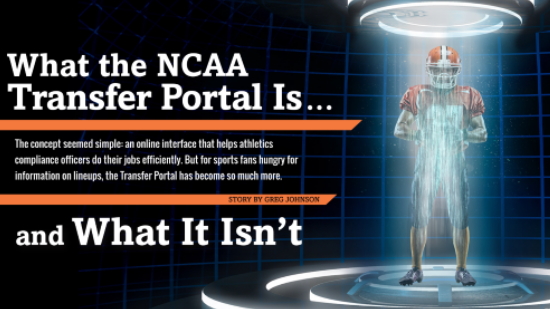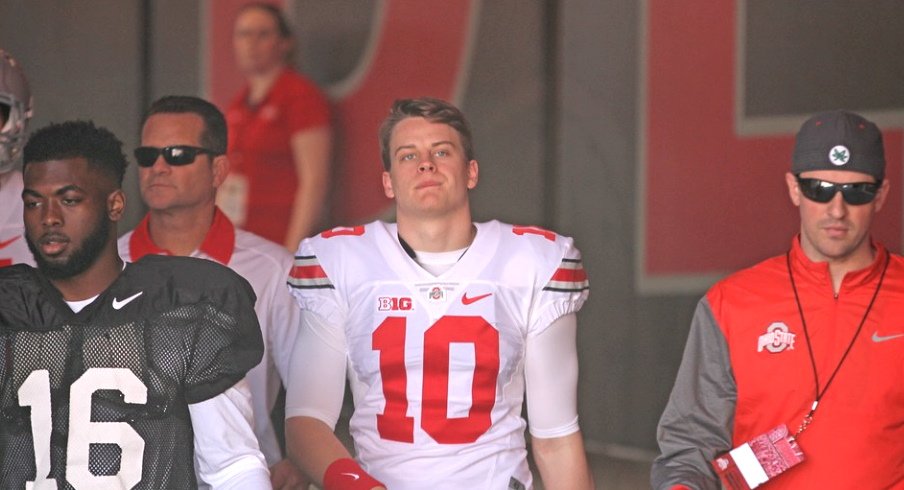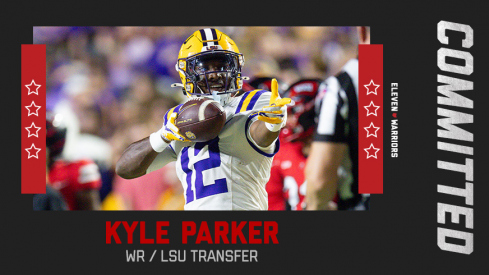I am fascinated by the NCAA's Transfer Portal for so, so many reasons, not the least of which is that it has a name taken from Star Trek and then applied to the comings and goings of college athletes to various universities.
The NCAA seems to hope that one day the Transfer Portal will in fact be an actual science fiction transporter capable of whisking away teens from Texas A&M to Utah State, because otherwise why in the hell would they use a graphic of a padded-up college athlete disintegrating into the ether and presumably reappearing before a booster wielding a wheelbarrow full of cash?

Maybe the NCAA knows that the reality of the portal (a school's compliance department and one member of each team's staff sitting on a folding chair in a dank basement staring at a CRT monitor while they smash the hell out of the F5 button) is equal parts unsexy yet intriguing, so they put out a whole big article this past autumn to explain what their take on the whole thing is. You know, the thing they themselves came up with.
The Transfer Portal was created as a compliance tool to systematically manage the transfer process from start to finish, add more transparency to the process among schools and empower student-athletes to make known their desire to consider other programs.
Okay, yes, go on.
The digital tools of athletics compliance aren’t often intriguing to fans and the media. Yet news of student-athletes entering their names in the portal appears on the tickers at the bottom of the screen on sports networks, and chatter about the portal fills hours on talk shows and provides fodder for opinion pieces.
Oh you think you're funny, huh, NCAA? Throwing some shade at us humble opinion-havers, that's cool, I'm only just a little hurt but I'll get over it. But since internet print is extremely cheap, I'm more than happy to offer my own take on what the Transfer Portal actually means for college sports despite your attempt to shame me into doing something else.
The short version is this: the NCAA's Transfer Portal is yet more evidence that the mythical "student-athlete" of yore really doesn't exist in any meaningful way in 2020.
WE GOTTA GET OUT OF HERE
By the NCAA's own estimation, the numbers involved here are huge. 15,000 Division I and II athletes used the portal during the 2018-2019 academic year, 10,000 of which were from D-I, and a quarter of those were football players. If you include both FBS and FCS teams in the equation and assume roughly 110 players per team, that could mean that about 10% of all D-I football players were in the Transfer Portal last season alone.
But ignore my admittedly incredibly dumb math and just read this, from NBCSports:
Back in mid-October, it was reported that a whopping 63 players had left [UCLA coach Chip] Kelly’s team since November of 2017 for various reasons. As a result, we wrote at the time ... some 53% of the roster was made up of freshmen alone.
... the Los Angeles Times is reporting that a 10th player has made his way into the NCAA transfer database since. The 10th is Matt Lynch, who announced via Twitter that, “[a]fter a lot of thought and discussion with my family, we think it is best for my situation to enter my name into the Transfer Portal.”
Yes, Matt! Go into the light! Join your brethren in the Elysian Fields, to be plucked like the graduate school-eligible berries you are and placed gently atop a whipped cream trifle somewhere in the Sun Belt.
Notably, three of the four quarterbacks in the College Football Playoff were transfers at some point in their college careers, and this kind of player movement is everywhere; Alabama, Notre Dame, Michigan, Georgia, Florida, Michigan again while I was in the process of writing this, Wisconsin, and a billion other programs are all part of this movement, and it has become an essential part of the ongoing arms race to stockpile talent in this era of college football.
SO LONG, FAREWELL
The rejoinder to all of these transfers is that most of these players won't be missed; the likes of the Crimson Tide and company likely have several dozen five-star athletes just waiting in the wings should a roster spot open up, which is a true statement and also completely irrelevant to the point.
College athletes looking to both maximize their potential and/or looking for a place that will guarantee them a scholarship sounds a hell of a lot like free agency to me, because it is.
To be clear, I wholeheartedly support it! I have zero problem with any athlete, particularly a football player, who puts their health on the line working a full time job trying to find a better full time job somewhere else. My sharecropping grandparents got the hell out of Kentucky as soon as they could because they figured if they were going to perform backbreaking labor for the rest of their lives, at least they could do it with a union salary in a steel mill.
By that same token, the NCAA reports that roughly half of the Division I football players in the Transfer Portal are walk-ons looking for a scholarship. In the business world (which I sometimes like to pretend to be a part of) we call that "maximizing your earning potential." A scholarship isn't a salary but it is a sort-of guarantee that can provide an athlete with more stability than being a walk-on.
ADIOS AMIGOS
All of this seems like a win-win; players get a chance to find a better opportunity to earn a scholarship or more playing time, and the athletic program can shuffle players and scholarships around as it sees fit. Maybe Ohio State gets a Justin Fields to lead them to a Big Ten title, and maybe San Diego State finds a tight end taller than six foot one. Either way, seems like a pretty good deal for everyone involved.
So why can't we talk about it? Shuffle the playing cards a little bit? Spill the tea about who's leaving and who's staying and who should leave but won't and who is staying but we're pissed about it?
Well, duh: it's because it's still an unequal relationship. Millionaire coaches at blue blood programs nudging players off their rosters because it's easier than ever before is a lot more common than "Heisman candidate seeks single Big Ten football program for long walks on the beach and championships." The truth is that some of the players entering the Transfer Portal aren't doing so because of the opportunities that it affords, they're doing it because it's their best chance for meaningful playing time and their current program is telling them unequivocally that it'll never happen for them there.
That sucks, and while playing time is never guaranteed in any sport, it also speaks to the inherent risk that college athletes undertake when they sign their letters of intent.
And, ultimately, I guess another reason why we don't want to speculate too openly about who is going to leave or stay via the Transfer Portal because it's simply too nakedly mercenary for our blood. At heart, a lot of us still want to believe that college sports in 2020 looks exactly how Francis Schmidt or Fielding Yost would've intended it to.
It does not, and the Transfer Portal is just the latest indicator of that fact. As a tool, the Transfer Portal is smart, accessible, and perfectly reflects the needs of college athletes and our desires as fans. But its more useful purpose might be as a barometer of amateurism in college sports.


